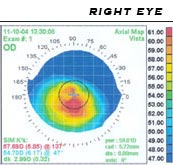
Photo from wikipedia
PURPOSE Deformations of the retina such as staphylomas in myopia or scleral flattening in high intracranial pressure can be challenging to quantify with en face imaging. We describe an OCT… Click to show full abstract
PURPOSE Deformations of the retina such as staphylomas in myopia or scleral flattening in high intracranial pressure can be challenging to quantify with en face imaging. We describe an OCT based method for the generation of quantitative posterior eye topography maps in normal and pathologic eyes. METHODS Utilizing "whole eye" OCT we corrected for subjects' optical distortions to generate spatially accurate posterior eye OCT volumes and created local curvature (KM, mm) topography maps for each consented subject. We imaged nine subjects, three normal, two with myopic degeneration (MD), and four with papilledema including one that was imaged longitudinally. RESULTS Normal subjects mean temporal KM was 0.0923 mm, nasal KM was 0.0927 mm, and KM local variability was 0.0162 mm. In MD subjects KM local variability was higher at 0.0836 mm. In papilledema subjects nasal KM was flatter compared to temporal KM (0.0709 mm vs. 0.0885 mm). Mean intrasession KM repeatability for all subjects was 0.0036 mm. CONCLUSION We have developed an OCT based method for quantitative posterior eye topography that offers the ability to analyze local curvature with micron scale resolution and offers the potential to help clinicians and researchers characterize subtle, local retinal deformations earlier in patients and follow their development over time.
Journal Title: Retina
Year Published: 2020
Link to full text (if available)
Share on Social Media: Sign Up to like & get
recommendations!